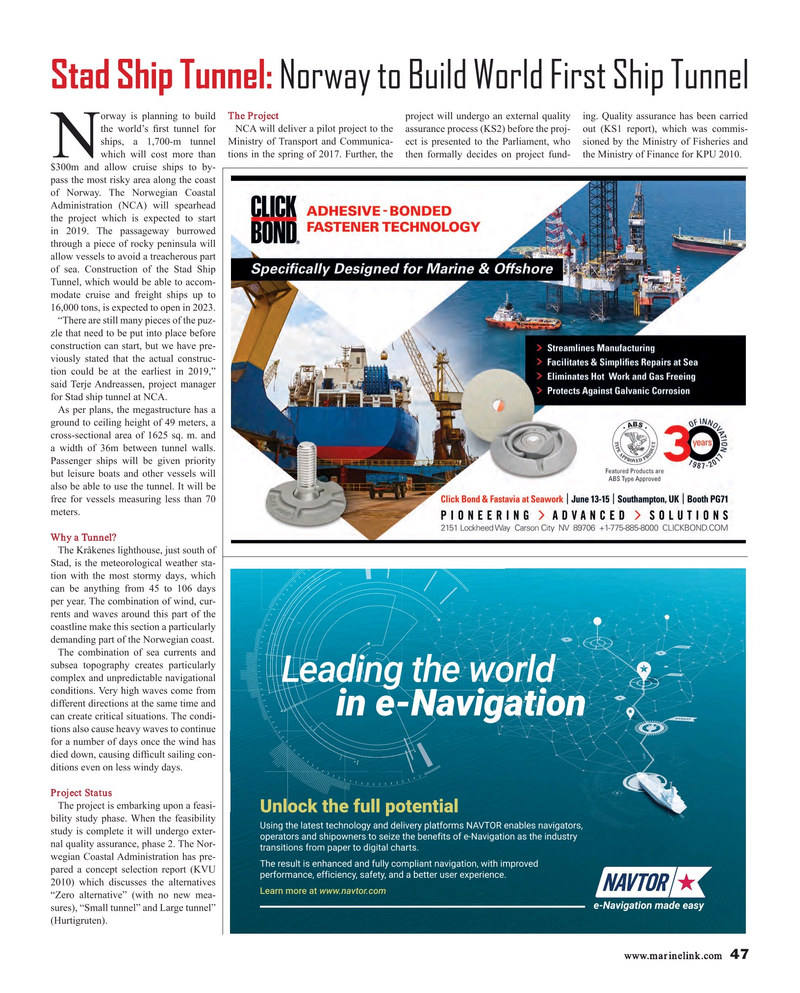
Page 47: of Maritime Reporter Magazine (May 2017)
The Marine Propulsion Edition
Read this page in Pdf, Flash or Html5 edition of May 2017 Maritime Reporter Magazine
Stad Ship Tunnel: Norway to Build World First Ship Tunnel orway is planning to build The Project project will undergo an external quality ing. Quality assurance has been carried the world’s ? rst tunnel for NCA will deliver a pilot project to the assurance process (KS2) before the proj- out (KS1 report), which was commis- ships, a 1,700-m tunnel Ministry of Transport and Communica- ect is presented to the Parliament, who sioned by the Ministry of Fisheries and
Nwhich will cost more than tions in the spring of 2017. Further, the then formally decides on project fund- the Ministry of Finance for KPU 2010.
$300m and allow cruise ships to by- pass the most risky area along the coast of Norway. The Norwegian Coastal
Administration (NCA) will spearhead the project which is expected to start in 2019. The passageway burrowed through a piece of rocky peninsula will allow vessels to avoid a treacherous part of sea. Construction of the Stad Ship
Tunnel, which would be able to accom- modate cruise and freight ships up to 16,000 tons, is expected to open in 2023.
“There are still many pieces of the puz- zle that need to be put into place before construction can start, but we have pre- viously stated that the actual construc- tion could be at the earliest in 2019,” said Terje Andreassen, project manager for Stad ship tunnel at NCA.
As per plans, the megastructure has a ground to ceiling height of 49 meters, a cross-sectional area of 1625 sq. m. and a width of 36m between tunnel walls.
Passenger ships will be given priority but leisure boats and other vessels will also be able to use the tunnel. It will be free for vessels measuring less than 70 meters.
Why a Tunnel?
The Kråkenes lighthouse, just south of
Stad, is the meteorological weather sta- tion with the most stormy days, which can be anything from 45 to 106 days per year. The combination of wind, cur- rents and waves around this part of the coastline make this section a particularly demanding part of the Norwegian coast.
The combination of sea currents and subsea topography creates particularly complex and unpredictable navigational conditions. Very high waves come from different directions at the same time and can create critical situations. The condi- tions also cause heavy waves to continue for a number of days once the wind has died down, causing dif? cult sailing con- ditions even on less windy days.
Project Status
The project is embarking upon a feasi- bility study phase. When the feasibility study is complete it will undergo exter- nal quality assurance, phase 2. The Nor- wegian Coastal Administration has pre- pared a concept selection report (KVU 2010) which discusses the alternatives “Zero alternative” (with no new mea- sures), “Small tunnel” and Large tunnel” (Hurtigruten).
www.marinelink.com 47
MR #5 (42-49).indd 47 MR #5 (42-49).indd 47 5/4/2017 9:07:28 AM5/4/2017 9:07:28 AM

 46
46

 48
48
